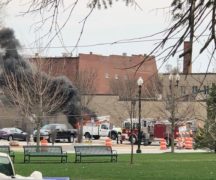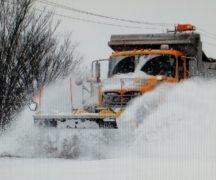By JAN LARSON McLAUGHLIN
BG Independent News
Bowling Green Fire Division has ignited some new goals for the new year – shifting its focus to fire prevention, examining response time, and collecting data for a future third fire station in the city.
These concepts and more are discussed in the fire division’s five-year strategic plan presented recently to city council. The division averages 3,500 calls a year, with 80 percent being EMS runs and the other 20 percent being fire calls for everything from structures, to cars to dumpsters.
One of Fire Chief Tom Sanderson’s main goals for the division is to add an emphasis on fire prevention.
“Historically, fire departments focus all their training and finances on fire suppression,” the chief said. But Sanderson would like to shift some focus to prevention as well. “We are charged with educating the community on how to reduce the risk of fires.”
So the fire division will be working to develop a community risk reduction program that will help protect homes, businesses – and his firefighters.
“My biggest concern as a fire chief – what keeps me up at night – is firefighter safety,” Sanderson said. “Firefighters don’t die if a fire never occurs.”
The fire division is not able to do annual inspections of all businesses in the city, so the chief wants to offer a risk reduction program. Unlike inspections, which some in the business community might interpret as costly or threatening, the prevention program will likely be viewed as a helpful service.
“We’re not able to do comprehensive fire safety inspections annually,” Sanderson said. “We’re trying to shift our focus. The goal is to help businesses stay in business.”
The chief pointed out the fire last year that crippled an iconic business, the Corner Grill. Such incidents may be able to be prevented by a community risk reduction program, he said.
False fire alarms
The fire division’s strategic plan also addresses false alarm calls at Bowling Green State University, which were formerly a problem since they wasted the division’s time and required equipment to be used needlessly.
However, Sanderson said that a recent investment by BGSU in new fire alarms has resulted in a 75 percent drop in false alarms on campus.
It used to be that burned popcorn or a hot hair-straightener combined with certain hair-care products set off alarms alerting the fire division.
“It was enough to trigger the smoke alarms, and that was enough to empty a residence hall,” he said. But that no longer happens. “BGSU put some stop gaps in place.”
Dispatching and response times
Changes are underway that should shave time off dispatch and response times. Instead of emergency callers having to repeat their information to the fire division, the information is relayed directly to the fire staff.
“That was an inefficient system,” Sanderson said. “This will put the trained firefighter and paramedic on the street faster.”
Other simple changes have been made, such as dispatchers asking for the location of the emergency first so help can be dispatched prior to all the information being gathered.
The average response time – 90 percent of the time with the outliers being dropped – is 6 minutes and 48 seconds. That time is good, Sanderson said, but ways to improve are always being examined.
Staffing the stations
The fire division has 50 on its staff, and saw the re-instatement of the deputy chief position last year – filled by Doug Isaacson.
The division relies on mutual aid from neighboring departments and automatic aid quite often, since an “effective response” for a structure fire is considered to be 17 firefighters. The division has 12 firefighters on duty at a time. That number currently is not a problem, but could be in the future if run volumes continue to increase, Sanderson said.
Low morale and uneven discipline have been issues in the department that the chief is trying to improve. He also plans to work on a succession program that will allow for smoother transitions when staff retire in the future.
Third station in the future
The strategic plan also mentions the possible need for a third fire station in the future. The chief predicted the next station will likely go toward the growth of the city, which seems to be headed north.
“We will continue to track our calls and response time,” Sanderson said. “We’re always evaluating that.”
But a third station will also mean more staffing and more equipment, he said.
Fire division finances
The fire division has made changes in order to cut costs. For example, applicants to fill open positions are now required to be certified firefighters and paramedics. In the past, the division would have to pay as much as $50,000 to train a new firefighter to become a paramedic.
“We’re very fiscally responsible. We utilize our resources and personnel very conservatively,” Sanderson said.
The chief plans to explore generating more money through user fees. There are presently no charges for fire calls. EMS calls are normally billed at between $500 and $600, depending on the equipment used on the run.
“It’s too expensive for the taxpayer to pay for EMS runs,” Sanderson explained.
But some departments generate funds by charging for car fires, since many auto insurance policies cover that cost. That could be a way to raise revenue without creating a hardship for city residents, he said.
Running a fire division can be quite costly, especially with the price of equipment. By time Bowling Green needs another aerial fire truck, Sanderson predicted the cost would be close to $1.5 million.





